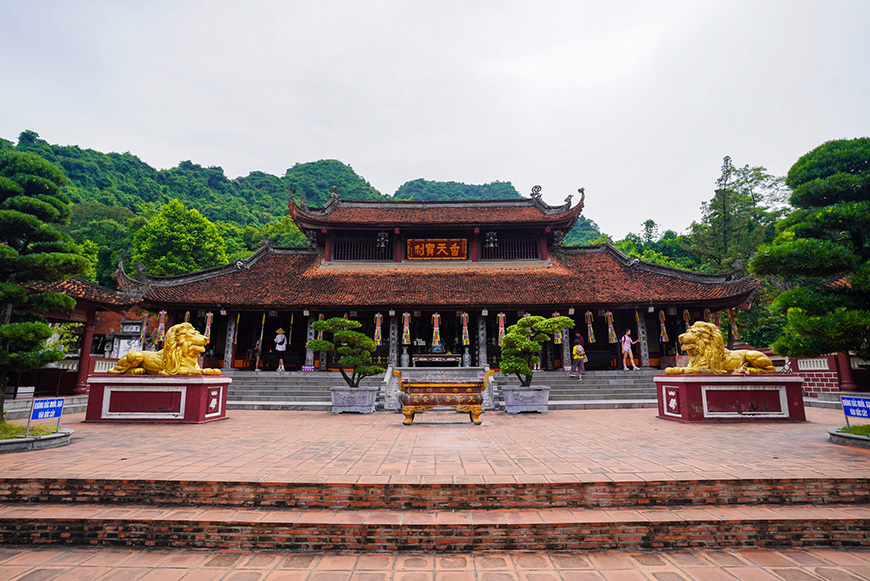 The Perfume (Hương) Pagoda is Vietnam's most revered Buddhist pilgrimage site - Mr Linh's Adventures
The Perfume (Hương) Pagoda is Vietnam's most revered Buddhist pilgrimage site - Mr Linh's AdventuresVietnam: a land of diverse and living spiritualities
Vietnamese spirituality is deeply rooted in daily life and shapes social interactions. It is a pragmatic and adaptable spirituality that allows followers to draw from a pluralistic pantheon to meet their daily needs. In the Land of the Dragon, spiritual tourism is not just about visiting monuments; it's an exploration of living practices, a dynamic syncretism, and the deep connections between belief, community, and national identity.
Typology of places of worship: architecture and spirituality
As social and ritual centers, Vietnam's sacred sites are divided into several categories, each reflecting a facet of local spirituality.
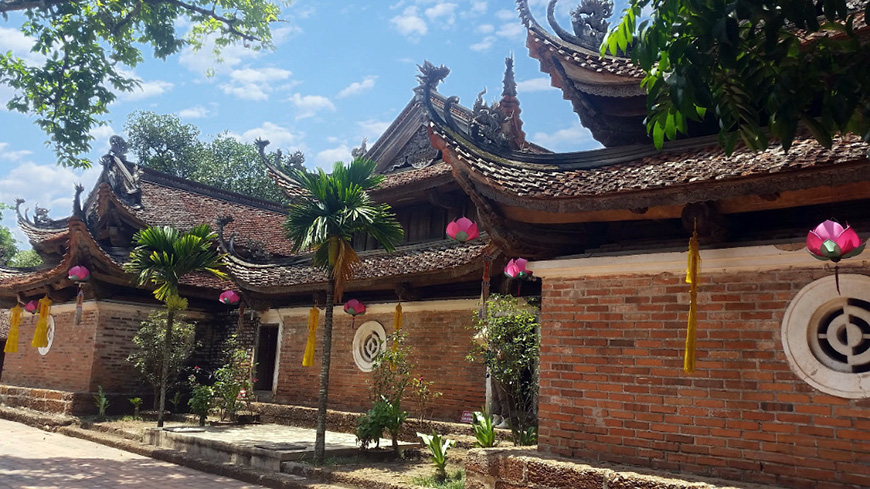 Tay Phuong Pagoda is one of the oldest pagodas in Vietnam - Mr Linh's Adventures Team
Tay Phuong Pagoda is one of the oldest pagodas in Vietnam - Mr Linh's Adventures TeamBuddhist pagodas (Chùa)
Pagodas, or chùa, are centers for meditation, teaching, and major celebrations such as Tết or Vesak, and they dominate Vietnam's spiritual landscape. Buddhism arrived in the Land of the Dragon as early as the 2nd century, first through China in the Red River Delta and then through India in the Mekong Delta. This dual influence gave rise to two distinct architectural styles: In the North and Central regions, Mahāyāna Buddhism is characterized by pagodas with curved, layered roofs and an abundance of Buddha and Bodhisattva statues. In the South, the more minimalist Theravāda Buddhism is distinguished by saffron and white colors and an architecture centered on a stupa.
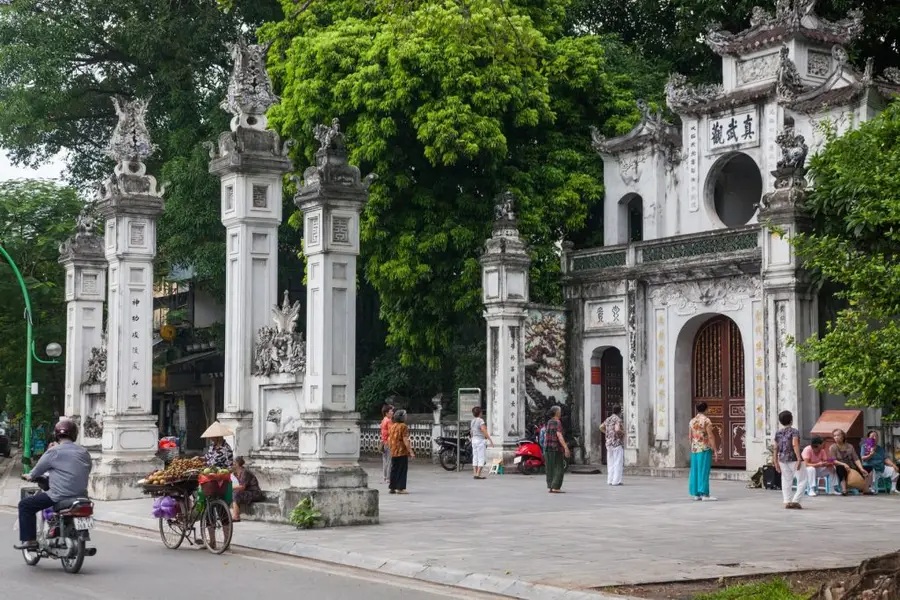 Quan Thanh Temple, also known as Tran Vu Temple, is a historic Taoist temple in Hanoi
Quan Thanh Temple, also known as Tran Vu Temple, is a historic Taoist temple in HanoiTemples (Đền) and communal houses (Đình)
While pagodas are the domain of Buddhism, đền (temples) and đình (communal houses) embody the heart of Vietnam's "folk religion" (Tin ngưỡng dân gian). Each village has its own tutelary spirit temple, underscoring the communal nature of this spirituality. The communal houses are also places for festivals and ceremonies that strengthen social bonds.
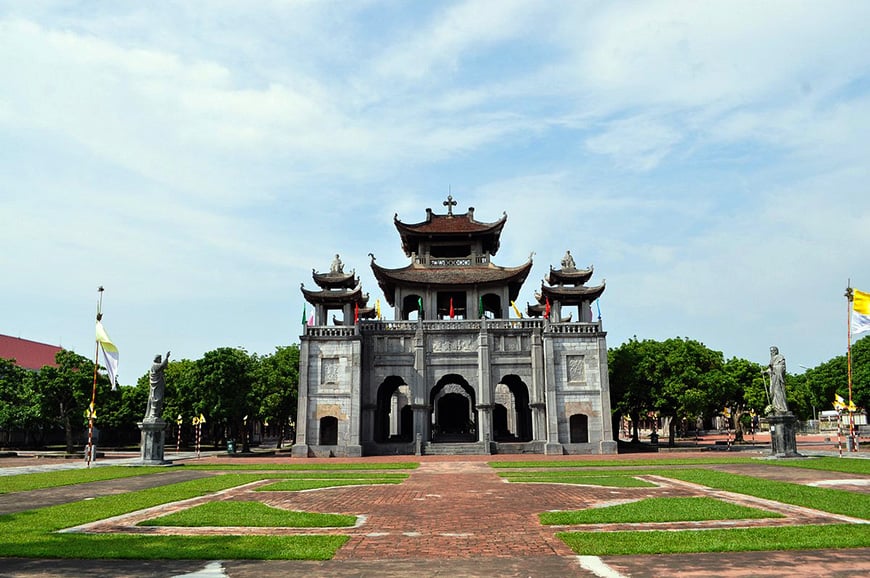 Phat Diem Cathedral is an eclectic blend of Vietnamese and European architectural styles
Phat Diem Cathedral is an eclectic blend of Vietnamese and European architectural stylesCatholic churches
Christianity was introduced to Vietnam in the 16th century by missionaries, notably Spanish and Portuguese. Although it initially met with resistance, it gradually grew, particularly during French colonization, leading to the construction of large cathedrals across the country. One of the most fascinating manifestations of this establishment is the architectural fusion that occurred, such as at Phát Diệm Cathedral in Ninh Bình province, a masterpiece of inculturation that integrates curved roofs and Vietnamese dragon sculptures into a Christian structure.
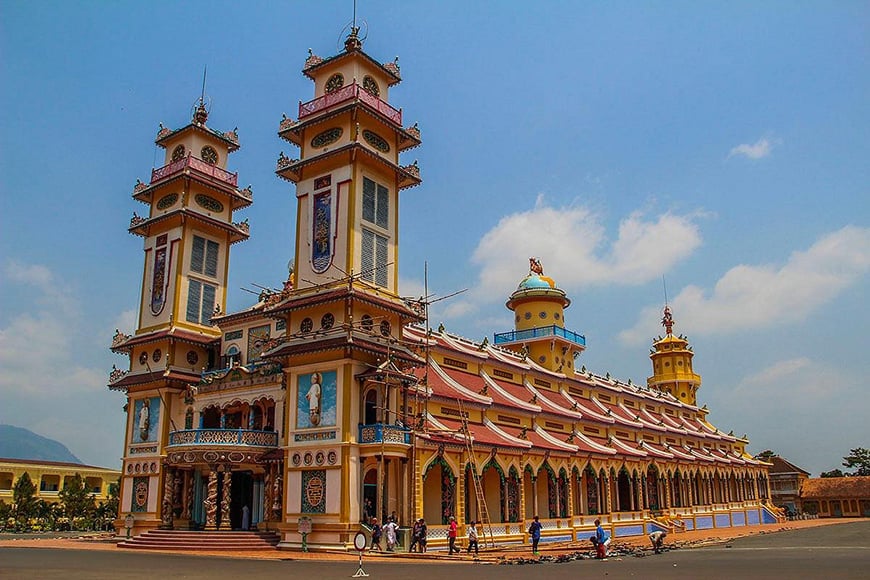 Famous for a unique architectural style, Cao Dai Temple is the center of Caodaism faithful in South Vietnam
Famous for a unique architectural style, Cao Dai Temple is the center of Caodaism faithful in South VietnamHindu and Caodaist sanctuaries
Vietnam is also a land of multiple influences, the presence of which is felt in more marginal but equally fascinating spiritualities.
Caodaism, born in Southern Vietnam, is a unique modern syncretism that fuses various religions, including Buddhism, Confucianism, and Islam. In addition, the
Mỹ Sơn sanctuary, a remnant of the
Champa kingdom, is a testament to the country's Hindu heritage with its brick temples and sculptures of deities like Vishnu.
The two founding pillars: ancestor worship and the Mother Goddesses
Ancestor worship
This cult, which predates the arrival of Buddhism and was reinforced by Confucianism, is the true foundation of Vietnamese society. It is the oldest and most universal spiritual practice, based on the belief that the souls of the deceased watch over their descendants. The family altar (bàn thờ tổ tiên) is a central element in every home, serving as a bridge between the visible and invisible worlds. This practice is a pillar of social structure and filial piety.
 Incense is believed to act as a bridge between the physical, ancestors and deities - Mr Linh's Adventures
Incense is believed to act as a bridge between the physical, ancestors and deities - Mr Linh's AdventuresThe cult of the Mother Goddesses (Đạo Mẫu)
Recognized by UNESCO, this cult honors female deities linked to nature. It is manifested through spectacular rituals like the Hầu đồng, a trance ceremony where a medium embodies the goddesses to distribute blessings. This cult illustrates the fluidity of Vietnamese spirituality, as evidenced by pilgrims who pray to both Buddha and the Mother Goddesses at the Perfume Pagoda.
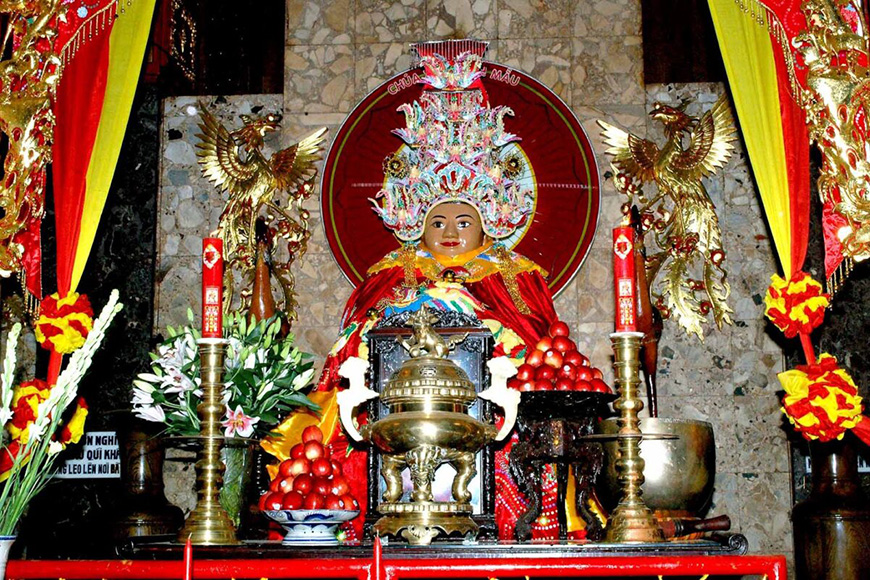 Recognized by UNESCO, Đạo Mẫu significant part of Vietnamese folk religion
Recognized by UNESCO, Đạo Mẫu significant part of Vietnamese folk religionA spiritual journey in three stages
For a complete immersion, a spiritual travel experience can be structured by region, with each offering distinct experiences.
The North: the origins of Buddhism and Confucianism
Northern Vietnam is the historical birthplace of the spiritual traditions that have forged the Vietnamese identity.
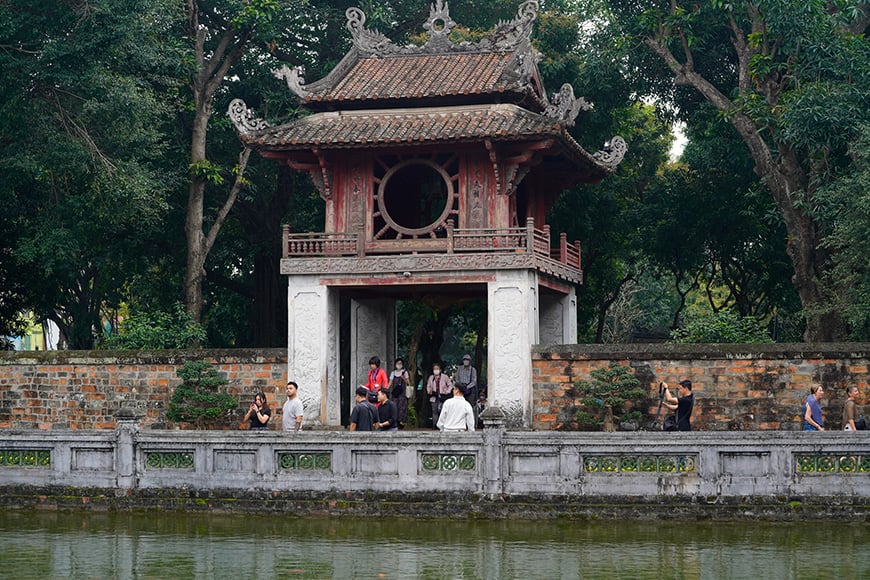 The Temple of Literature is a monument to Confucius and Vietnam's first university - Mr Linh's Adventures
The Temple of Literature is a monument to Confucius and Vietnam's first university - Mr Linh's AdventuresThe Temple of Literature
Founded in 1070 by Emperor Lý Thánh Tông, Văn Miếu - Quốc Tử Giám represents the intellectual and cultural heart of medieval Vietnam. Originally dedicated to Confucius, this site served as the national higher education center. Its five successive courtyards tell the story of Vietnamese education, from the monumental entrance to the main temple, passing through the Lake of Literature and the Pavilion of the Constellation of Literature, while its 82 stone steles honor imperial graduates and recall the place of knowledge in Vietnamese culture.
The Center: imperial pagodas and remnants of the Champa kingdom
Central Vietnam is distinguished by its historical position as a crossroads where Northern traditions meet older civilizations. With its temples and palaces, the Huế Citadel, a
UNESCO World Heritage site, is a symbol of Confucian imperial spirituality under the Nguyễn dynasty.
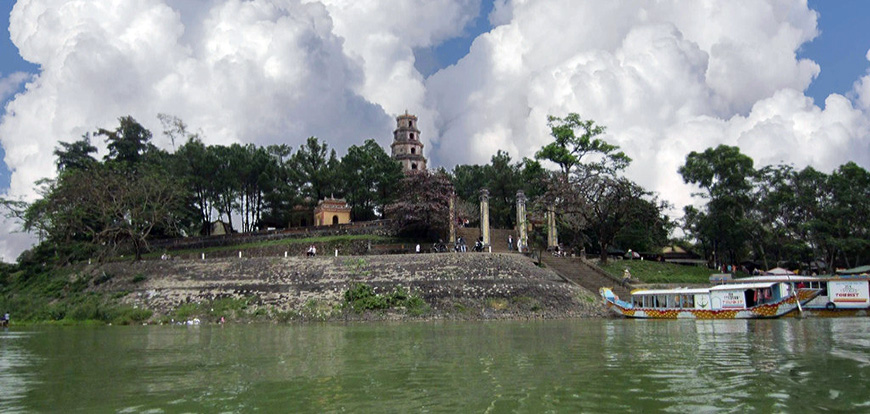 Thien Mu Pagoda is one of the most fascinating and ancient pagoda in Hue city - Mr Linh's Adventures Team
Thien Mu Pagoda is one of the most fascinating and ancient pagoda in Hue city - Mr Linh's Adventures TeamThe Thiên Mụ Pagoda
An emblem of Huế, this pagoda has been a major Buddhist center since its founding. According to local legend, a mysterious old woman appeared on the hill, predicting that a great lord would build a pagoda there and found a powerful dynasty. This prophecy proved to be prescient, as Lord Nguyễn Hoàng, impressed by it, had the pagoda built in 1601. The Pagoda of the Celestial Lady is famous for its seven-story octagonal structure, with each floor dedicated to an important event in the life of Buddha. A major symbol of Vietnamese history and spirituality, it is also a silent witness to the country's political and social transformations, associated with the resistance against the regime of the time.
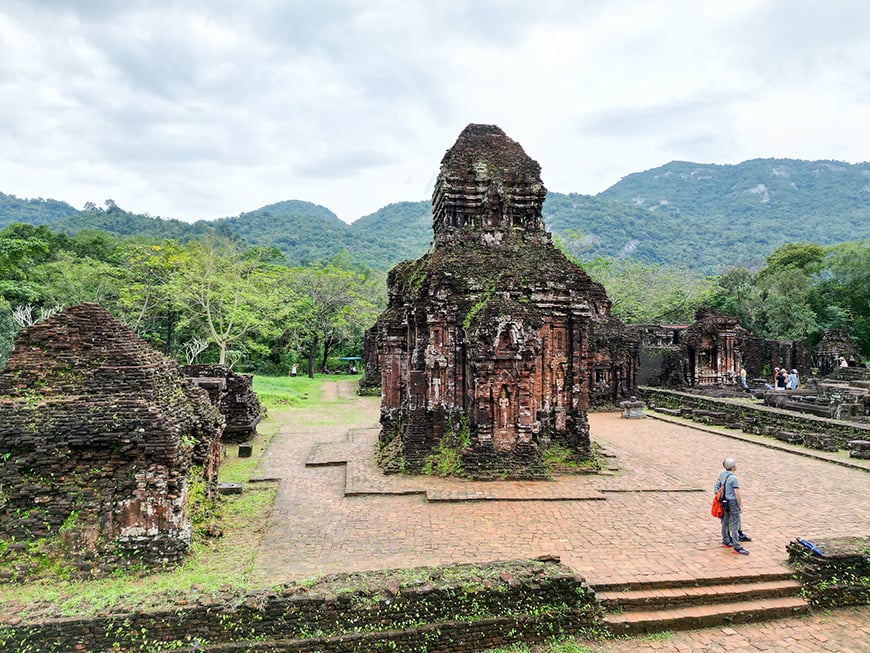 Mỹ Sơn Sanctuary is a complex of temple and tower structures built by the Cham people - Mr Linh's Adventures
Mỹ Sơn Sanctuary is a complex of temple and tower structures built by the Cham people - Mr Linh's AdventuresThe Mỹ Sơn sanctuary
Further South, the Mỹ Sơn sanctuary, about 45 km west of Hoi An—a 3-hour drive from Huế via the Hải Vân Pass—is the legacy of a now-vanished civilization: the
Champa kingdom, an empire that flourished between the 4th and 13th centuries. A World Heritage site, this architectural complex of brick temples is a remnant of the Hindu religion in Vietnam, with its sculptures of deities like Vishnu. The site served as a place of worship and burial for Cham kings. Among the most remarkable structures are the temples of Brahma and Shiva, which illustrate the unique architecture of the Cham people.
The coexistence of these sites—the
imperial Buddhism of Huế and the Hinduism of Mỹ Sơn—highlights a unique dialogue between two great spiritual civilizations, offering a historical depth not found anywhere else in the country.
The South: a melting pot of frontier spiritualities
Southern Vietnam, with its more recent history and openness to the world, is the birthplace of unique and resolutely syncretic spiritualities. Caodaism, a native religion of the region, symbolizes this ability to fuse beliefs to create a new doctrine unique to Southern Vietnam.
 Mong Phu Communal House - Duong Lam Village - Mr Linh's Adventures Team
Mong Phu Communal House - Duong Lam Village - Mr Linh's Adventures TeamNúi Sam (Sam Mountain)
Located in An Giang province, Mekong Delta, this pilgrimage site is a perfect example of this syncretism. Housing nearly 200 pagodas and temples, including the famous Hang Pagoda (Cave Pagoda) and Linh Son Pagoda, the site is particularly dedicated to the cult of the goddess Bà Chúa Xứ, whose statue is believed to be of Hindu origin. The veneration of this female figure blends with Buddhist rites and the cult of the national hero Thoại Ngọc Hầu, whose tomb is located at the foot of the mountain.
An initiatory journey
Spiritual tourism in Vietnam is the unique experience of immersing oneself in a culture where spirituality is a living fabric and not just a superficial layer. It is an initiatory journey whose richness lies not only in the beauty of the monuments but also in the understanding of their social, ritual, and identity-shaping function.